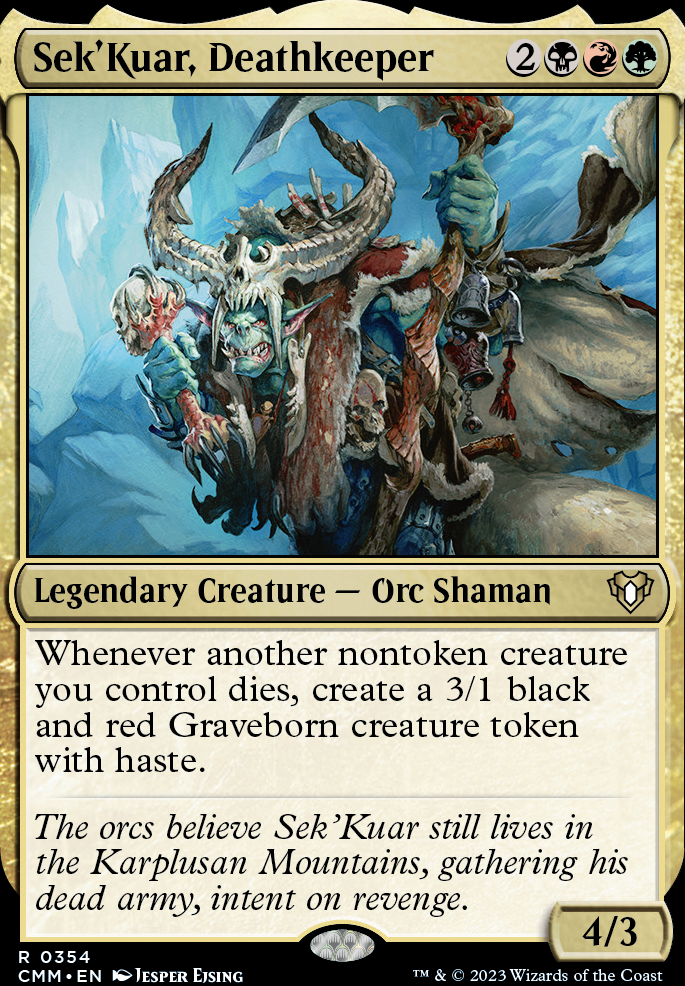Creature (33)
- 1x Ashenmoor Liege
- 1x Blood Artist
- 1x Bloodghast
- 1x Bloodsoaked Champion
- 1x Caller of the Claw
- 1x Caustic Caterpillar
- 1x Eternal Witness
- 1x Goblin Sharpshooter
- 1x Grave Titan
- 1x Imperial Recruiter
- 1x Ingot Chewer
- 1x Liliana, Heretical Healer Flip
- 1x Massacre Wurm
- 1x Midnight Reaper
- 1x Murderous Redcap
- 1x Nesting Dragon
- 1x Nether Traitor
- 1x Pawn of Ulamog
- 1x Phyrexian Plaguelord
- 1x Pitiless Plunderer
- 1x Poison-Tip Archer
- 1x Purphoros, God of the Forge
- 1x Ramunap Excavator
- 1x Reassembling Skeleton
- 1x Sakura-Tribe Elder
- 1x Scavenging Ooze
- 1x Shriekmaw
- 1x Sidisi, Undead Vizier
- 1x Thragtusk
- 1x Viscera Seer
- 1x Whisperwood Elemental
- 1x Wild Cantor
- 1x Withered Wretch
Land (37)
- 1x Badlands
- 1x Bayou
- 1x Blood Crypt
- 1x Bloodstained Mire
- 1x Bojuka Bog
- 1x Cinder Glade
- 1x Command Tower
- 1x Dragonskull Summit
- 1x Fire-Lit Thicket
- 3x Forest
- 1x Graven Cairns
- 1x High Market
- 1x Karplusan Forest
- 1x Llanowar Wastes
- 1x Marsh Flats
- 3x Mountain
- 1x Overgrown Tomb
- 1x Polluted Delta
- 1x Reflecting Pool
- 1x Rootbound Crag
- 1x Smoldering Marsh
- 1x Stomping Ground
- 1x Sulfurous Springs
- 4x Swamp
- 1x Taiga
- 1x Twilight Mire
- 1x Verdant Catacombs
- 1x Westvale Abbey Flip
- 1x Wooded Foothills
- 1x Woodland Cemetery
Instant (5)
Commander (1)
Sorcery (11)
- 1x Blasphemous Act
- 1x Demonic Tutor
- 1x Din of the Fireherd
- 1x Dread Return
- 1x Exhume
- 1x Farseek
- 1x Gaze of Granite
- 1x Living Death
- 1x Skyshroud Claim
- 1x Victimize
- 1x Void
Enchantment (7)
- 1x Dictate of Erebos
- 1x Elemental Bond
- 1x Evolutionary Leap
- 1x Goblin Bombardment
- 1x Outpost Siege
- 1x Parallel Lives
- 1x Tombstone Stairwell
Artifact (6)
Suggestions
Updates Add
Comments
Attention! Complete Comment Tutorial! This annoying message will go away once you do!
Important! Formatting tips — Comment Tutorial — markdown syntax
Please login to comment
| Date added | 5 years |
| Last updated | 5 years |
| Legality | This deck is Commander / EDH legal. |
| Rarity (main - side) | 6 - 0 Mythic Rares 55 - 0 Rares 18 - 0 Uncommons 11 - 0 Commons |
| Cards | 100 |
| Avg. CMC | 3.37 |
| Tokens | Bear 2/2 G, Beast 3/3 G, Dragon 2/2 R, Dragon Egg 0/2 R, Eldrazi Spawn 0/1 C, Elemental 5/5 BR, Emblem Liliana, Defiant Necromancer, Graveborn 3/1 BR, Human Cleric 1/1 BW, Manifest 2/2 C, Treasure, Zombie 2/2 B, Zombie 2/2 B w/ Haste |
| Folders | VaevictisAndTheAristocrats, decks i like, Ideas |
| Votes | |
| Ignored suggestions | |
| Shared with | |
| Views |

